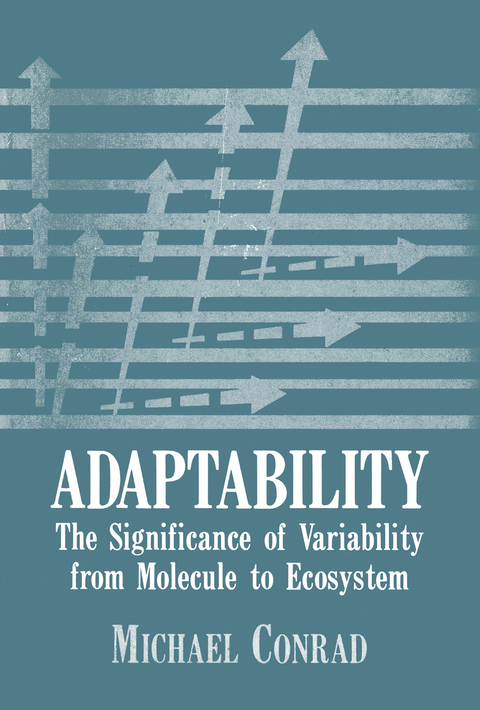
Adaptability
Springer-Verlag New York Inc.
978-1-4615-8329-5 (ISBN)
1. The Ecosystem Process.- 1.1. Pond Water in a Flask.- 1.2. The Uncertain Ecosystem.- 1.3. Balance.- 1.4. The Theory of Evolution.- 2. The Laws of Dissipation.- 2.1. Energy and Entropy Transformations in Open Systems.- 2.2. The Importance of Dissipation.- 2.3. Statistical Significance of Dissipation.- 2.4. Breaking the Conservation Law.- 2.5. Further Remarks on the Origin of Irreversibility.- 2.6. Forgetting Perturbation.- 2.7. Ignoring Perturbation.- 2.8. Reducing Perturbation and the Significance of Quantum Variability.- References.- 3. The Dissipative Ecosystem.- 3.1. Selective Dissipation and Self-Reproduction.- 3.2. Self-Assembly and Self-Reorganization.- 3.3. Dissipative Patterns and Dissipative Repatterning.- 3.4. Patterns of Activity.- 3.5. Information Unbound.- 3.6. Information and Organization.- 3.7. The Chessboard Analogy.- 3.8. The Forgetful Ecosystem.- References.- 4. Statistical Aspect of Biological Organization.- 4.1. Behavioral Description.- 4.2. Statistical Measures.- 4.3. Fundamental Identity.- 4.4. Fundamental Inequality.- 4.5. Regular Capacity.- 4.6. Time Scales and Information Flow.- 4.7. Information Transfer Picture.- 4.8. Further Remarks on Information Transfer.- 4.9. Two-Time Formalism.- 4.10. Diversity of Behavior.- 4.11. The Variability of Biological Matter.- Addendum: Structural Correspondence between Transition Scheme and Two-Time Formalism.- References.- 5. Hierarchical Aspect of Biological Organization.- 5.1. Compartmental Structure of the Ecosystem.- 5.2. States of Compartments.- 5.3. Reference Structures.- 5.4. Transition Schemes Again.- 5.5. The Canonical Representation.- 5.6. Statistical Laws.- 5.7. Interpretation of the Terms.- 5.8. Further Biological Correlates.- References.- 6. Evolutionary Tendency of Adaptability.- 6.1. The BasicArgument.- 6.2. General Mechanisms.- 6.3. Correlation and Decorrelation Mechanisms.- 6.4. Apparent Paradox of Competition.- 6.5. Mechanisms and Modes of Adaptability.- 6.6. Dispensing with Adaptability.- 6.7. Physiological Tendencies.- 6.8. Upper Bound of Adaptability.- 6.9. Self-Consistency of Hierarchical Adaptability Theory.- 6.10. Segregation of Genotype and Phenotype.- 6.11. Operational Definition of Adaptability.- References.- 7. The Meaning of Efficiency.- 7.1. The Connection between Efficiency and Fitness.- 7.2. Thermodynamic Parameters of Efficiency.- 7.3. Fitness and Efficiency in the Light of Thermodynamics.- 7.4. Reformulating Statements about Efficiency.- 7.5. Biomass and Turnover in the Context of Efficiency.- 7.6. Evolution of Efficiency.- References.- 8. The Connection between Adaptability and Dynamics.- 8.1. Autonomy, Predictability, and the Bath of Unrepresented Adaptabilities.- 8.2. Biology of Stability, Instability, and Bifurcation.- 8.3. Interpretation of a Classical Model and Significance of Chaos.- 8.4. H(??) versus ??.- References.- 9. The Connection between Adaptability and Reliability.- 9.1. Embedded Communication Network and the In-Principle Solution.- 9.2. Essentials of the Proof.- 9.3. More General Situations and Qualifying Comments.- 9.4. Biochemical Proofreading.- 9.5. Interdependence of Reliability and Adaptability.- References.- 10. Adaptability Theory Analysis of the Genotype-Phenotype Relationship.- 10.1. The Mutation-Absorption Paradigm.- 10.2. Formalization of the Mutation-Absorption Model.- 10.3. The Bootstrap Principle of Evolutionary Adaptability.- 10.4. Issue of Neutralism and Significance of the Magnitudes.- 10.5. Adaptability of the Adaptive Landscape.- 10.6. Extension to Multigene Systems.- 10.7. Bootstrapping of theCyclic Nucleotide System.- 10.8. The Buffer Structure Principle of Phenotypic Organization.- 10.9. Bootstrapping Is Possible Only in Nondecomposable Systems.- 10.10. Relation to Other Discussions of Evolution and Development.- References.- 11. Compensation in Organisms and Populations.- 11.1. Homeostasis.- 11.2. The Niche and Its Role in Compensation.- 11.3. Factors Affecting the Allocation of the Entropies.- 11.4. The Connection between Adaptability and Complexity.- 11.5. Fundamental Constraints.- 11.6. Patterns of Adaptability in Populations.- 11.7. Evolution of the Higher Nervous System as Compensation.- 11.8. Example of a Different Kind (Homeothermy versus Poikilothermy).- 11.9. Vector Diagrams.- 11.10. Implications for the Etiology of Disease.- 11.11. Implications for the Treatment of Disease.- 11.12. Adaptability versus Adaptation.- References.- 12. Organization and Succession of Ecosystems.- 12.1. Microcosm Experiments and the Reality of Control.- 12.2. Ergodic Analogy.- 12.3. Evolutionary versus Ecological Stability.- 12.4. Environmental Homeostasis.- 12.5. Food Webs and Conservation Laws.- 12.6. Formal Connections to Components of Adaptability.- 12.7. Species Diversity.- 12.8. Detritus Pathway as Buffer System.- 12.9. Trophic Collapse and Trophic Elongation.- 12.10. Niche Divergence and Niche Convergence.- 12.11. Adaptability, Complexity, and the Stability of History.- 12.12. Succession to Instability.- References.- 13. Evolution and the Organization of Potentiality.- 13.1. Adaptability Theory of Species Formation.- 13.2. Lack of Adaptability in the Sexual Mechanism.- 13.3. Biogeographic Radiation and Volume of Life.- 13.4. Species Senescence and Evolution to Instability.- 13.5. Biological Organization and the History of Uncertainty (Review of the Theory).- 13.6. The Limits of Predictability.- References.- 14. The Age of Design.- 14.1. The Limitations of Prediction, Efficiency, and Planning.- 14.2. The Design of Economic Societies.- 14.3. Blind Chance and Better Chance.- Reference.
| Zusatzinfo | 408 p. |
|---|---|
| Verlagsort | New York, NY |
| Sprache | englisch |
| Maße | 152 x 229 mm |
| Themenwelt | Sachbuch/Ratgeber ► Natur / Technik ► Garten |
| Mathematik / Informatik ► Informatik ► Theorie / Studium | |
| Naturwissenschaften ► Biologie ► Evolution | |
| Naturwissenschaften ► Physik / Astronomie | |
| ISBN-10 | 1-4615-8329-2 / 1461583292 |
| ISBN-13 | 978-1-4615-8329-5 / 9781461583295 |
| Zustand | Neuware |
| Haben Sie eine Frage zum Produkt? |
aus dem Bereich


